The forecasts for the domestic economy are underpinned by several technical assumptions. The exchange rate is assumed to remain around its average level of early June 2008 (a trade-weighted index of around 73 and a $US exchange rate of around 96c). Interest rates are assumed to remain unchanged at their current levels. World oil prices (Tapis) are assumed to remain at around $US 140 per barrel. The farm sector forecasts are based on an assumed return to average seasonal conditions in the remainder of the forecasting period, but take into account the effects of sustained drought conditions in the preceding period.
Household consumption
The medium term outlook for household consumption is similar to Budget with forecasts for both 2007-08 and 2008-09 unchanged from Budget at 4½ per cent and 2¾ per cent respectively. In 2009-10, growth is expected to remain restrained.
Consumption growth slowed from 1.5 per cent in December to 0.7 per cent in March against a backdrop of rising borrowing costs and financial market instability. Since Budget, higher oil prices have further dampened consumer sentiment and there is continued evidence of weaker growth in consumer activity. Reflecting this, growth in the June quarter is likely to be subdued.
Chart 1: Household consumption and gross disposable income (real)
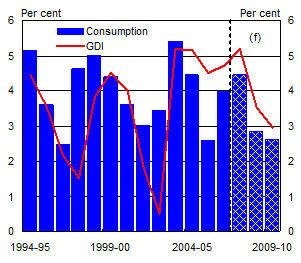
Source: ABS Cat. No. 5206.0 and Treasury.
Similar to the Budget outlook, it is anticipated that consumers will adjust to higher interest rates and lower returns on financial assets by increasing their rate of saving and reducing debt accumulation. This is supported by a fall in the value of lending finance since the start of 2008. With household disposable income growing at a faster rate than consumption (chart 1), the household saving ratio is expected to improve, consolidating its recovery in recent years (chart 2).
Moderate consumption growth is set to continue into 2009-10 with year average growth forecast to remain at 2¾ per cent. Recent increases in borrowing costs are expected to continue to weigh on growth. In addition, downside risks to the outlook have become more pronounced since Budget in light of higher oil prices, continued stock market volatility and lower consumer confidence.
Chart 2: Household Saving Ratio
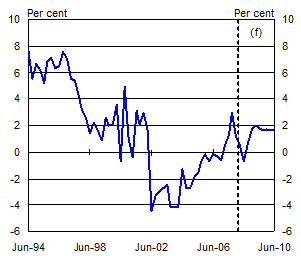
Source: ABS Cat. No. 5206.0 and Treasury.
Dwelling investment
The outlook for the residential construction sector has weakened since Budget, driven by weaker alterations and additions activity. The impact of higher interest rates continues to weigh on the sector, with recent partial data around housing finance and building approvals supporting this view.
Previous cash rate rises and independent bank increases are also being seen in weakening demand for renovations. While the forecast for 2008-09 is broadly unchanged for new dwelling investment, the outlook for alterations and additions has slightly deteriorated from Budget. New dwelling investment is expected to remain flat in 2008-09, while investment in alterations and additions is forecast to grow by 1 per cent, compared to the growth of 3 per cent forecast at Budget (Chart 3).
Chart 3: Dwelling investment (real)
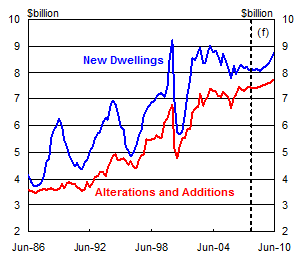
Source: ABS Cat. No. 5206.0 and Treasury.
Despite the weak outlook for dwelling investment in the medium term, fundamental forces in the housing market are suggestive of stronger activity in the longer term. With the population growing at the fastest rate in almost 20 years, supported by record levels of migration, underlying demand for housing continues to remain strong.
Chart 4: Dwelling Completions and Demand

Source: ABS Catalogue Numbers 3101.0, 8752.0, Census (1991, 1996, 2001 and 2006) and Treasury calculations.
New dwelling investment is expected to grow by 4½ per cent in 2009-10, reflecting strong underlying demand, as well as more attractive rental yields for investors. Investment in alterations and additions is also expected to pick up slightly in 2009-10, growing by 2 per cent.
Business investment
The outlook for new business investment is unchanged from Budget, with an expected increase of 9½ per cent in 2007-08 and 8½ per cent in 2008-09. The strong outlook for business investment is being supported by further rises in key non-rural commodity prices, and a strong Australian dollar. While business investment is expected to remain at very high levels in 2009-10, growth is expected to moderate to 4½ per cent in line with infrastructure and labour capacity constraints, particularly in the mining and construction industries.
Weakening business sentiment, continued uncertainty in global financial markets and weaker growth in the world economy are anticipated to result in softer non-mining related investment, particularly for new machinery and equipment. In contrast, larger mining and ancillary firms are expected to be largely insulated from higher funding costs because of their more robust profit outlooks.
New business investment as a proportion of nominal GDP is expected to remain high (Chart 5).
Chart 5: Business investment to GDP ratio (nominal)
Source: ABS Cat. No. 5206.0 and Treasury.
Total non-dwelling construction investment is expected to grow by 11½ per cent in 2007-08 and by 6 per cent in 2008-09. The forecast for 2007-08 is stronger than at Budget, reflecting a stronger-than-expected outcome for both engineering construction and non-residential buildings investment in the March quarter 2008.
New engineering construction investment is expected to increase by 13½ per cent in 2007-08 and by 8 per cent in 2008-09. Continued strength is this component reflects continued growth in mining projects funded from rises in commodity prices. Growth is expected to moderate to 3 per cent in 2009-10, but remain at high levels. A record amount of work yet to be done remains in the pipeline, but there is a risk that constraints arising from increased cost and labour supply pressures will delay some engineering construction investment.
Non-residential buildings investment is expected to grow by 9½ per cent in 2007-08 and 3½ per cent in 2008-09. Approvals data and low vacancy rates across the country suggest continued underlying strength in activity in the office market. Weakening growth in 2008-09 partly reflects continued tightness in commercial credit markets, with some building projects struggling to secure longer term finance. Growth is expected to strengthen to 5 per cent in 2009-10, as credit conditions become more favourable and consumer spending begins to strengthen, stimulating growth in the reta
il sector.
Inventories
Consistent with strong growth in domestic demand over the past year, private non-farm stocks are expected to contribute ¼ of a percentage point to GDP growth in 2007-08. Consistent with the outlook at Budget, the forecast slowdown in domestic demand growth in 2008-09 is expected to result in stocks detracting from GDP growth by around ¼ of a percentage point in 2008-09. There is no contribution to growth from inventories in 2009-10.
Farm stocks are expected to have a negligible effect on GDP growth over the next two years.
Public final demand
In real terms, expected new public final demand in 2008-09 has strengthened since Budget, up ½ a percentage point to 3½ per cent. This follows a downward revision to growth in 2007-08 to 4 per cent. The changes have been driven by stronger State and local expenditure, particularly investment which is expected to grow strongly over the forecast period (Table 3). Growth is expected to ease slightly to 3¼ per cent in 2009-10.
Table 3: Real new public expenditure
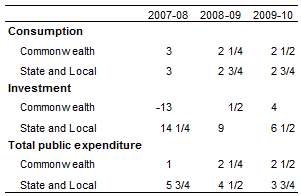
Source: Treasury.
The outlook for government consumption growth of 3 per cent in 2007-08 is stronger relative to Budget, reflecting stronger State and Local consumption. In 2008-09 and 2009-10, government consumption is expected to moderate to 2½ per cent, as Commonwealth consumption eases.
Growth in new public investment is also expected to moderate over the forecasting period. New public investment is expected to grow by 7½ per cent in 2008-09 and 6 per cent in 2009-10, following estimated growth of 8½ per cent in 2007-08. Strong State and Local investment in 2007-08 and 2008-09 is expected to drive public investment growth. Compared to Budget, the forecast for 2007-08 is weaker and the forecast for 2008-09 is stronger, reflecting some project delays into 2008-09.
New public demand has grown broadly in line with nominal GDP in recent times but is expected to fall as a proportion of the nominal economy over the forecast horizon (Chart 6).
Chart 6: Nominal public expenditure
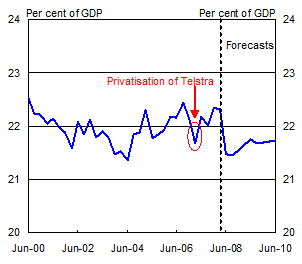
Source: ABS Cat. No. 5206.0 and Treasury.
Further project delays remain a risk to the investment profile, given existing capacity constraints and the high level of private sector investment.
Exports, imports and the current account deficit
Net exports are expected to subtract 2 percentage points from GDP growth in 2007-08, 1¼ percentage points in 2008-09, and ½ a percentage point in 2009-10. Compared with Budget, the expected subtraction for 2008-09 is a ¼ of a percentage point greater, reflecting higher imports of fuel in response to the explosion at the natural gas production facilities at Varanus Island, and the resulting interruption to some non-rural commodities exports.
Total export volumes are expected to grow by 5½ per cent in 2008-09, and 6 per cent in 2009-10. Commodity exports are expected to account for over 80 per cent of total export growth in 2008-09 and 2009-10.
Following the significant amount of investment of recent years, mining projects are expected to come online throughout the forecast horizon, and to support a significant boost in non-rural commodity exports, with volumes expected to increase by 6½ per cent in 2007-08, and 7½ per cent in 2008-09 and 2009-10, the fastest rates of growth in over a decade (Chart 7).
Chart 7: Non-rural commodity exports (year average)
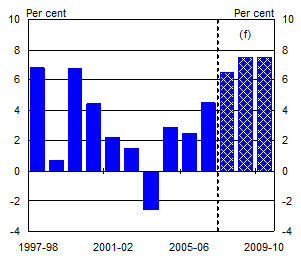
Source: ABS Cat. No. 5302.0 and Treasury.
By component, growth in iron ore exports is expected to contribute significantly to non-rural commodity export growth over the forecast period, as new entrants join existing producers to ramp up production. Mineral fuels are also expected to contribute strongly in 2008-09 as oil and gas projects come online.
Farm production is expected to rebound by 15 per cent in 2008-09 on the back of improved rainfall. This is lower than the 20 per cent growth expected at Budget, reflecting reduced expectations for this season's wheat production. Ongoing rainfall during the winter crop growing season will be critical. Contingent on average seasonal conditions continuing, farm production is forecast to increase by a further 4 per cent in 2009-10.
Rural exports are expected to fall by 10 per cent in 2007-08, reflecting drought-affected farm production in 2006-07 and 2007-08, and low levels of farm inventories. In line with the recovery in farm production, rural exports are forecast to grow by 11 per cent in 2008-09 and 2009-10.
Following solid growth in 2007-08, a slowdown in world growth in 2008-09, sustained strength in the exchange rate and heightened global competition are expected to weigh on exports of elaborately transformed manufactures and services. ETM export growth is expected to slow substantially to just ½ per cent in 2008-09 and 2009-10. Services exports are also expected to slow, easing to 1½ per cent in 2008-09 and 2 per cent in 2009-10.
Imports of goods and services are expected to grow by 9½ per cent in 2008-09 and ease to 6 per cent in 2009-10 as domestic demand moderates. Compared with Budget, the current forecasts are ½ of a percentage point higher for 2007-08 and 2008-09. The higher exchange rate continues to provide support to imports.
The terms of trade are forecast to increase by 5 per cent in 2007-08, and 15 per cent in 2008-09, and remain flat in 2009-10. Compared with Budget, the current forecast is 1 percentage point lower in 2008-09, reflecting higher imported oil prices, partially offset by higher iron ore contract prices. One major Australian supplier has negotiated increases of between 80 and 97 per cent for iron ore contract prices for the 2008-09 Japanese fiscal year, while prices for metallurgical coal and thermal coal have surged by around 200 per cent and 125 per cent respectively.
Current strong demand for commodities and constrained global supply should continue to support a high level of prices. However, there is considerable uncertainty regarding the future path of commodity prices with significant falls and further rises possible.
Chart 8: Terms of trade

Source: ABS Cat. No. 5302.0 and Treasury.
The trade balance is expected to move into small surpluses of ¼ of a per cent of GDP in 2008-09 and 2009-10, largely reflecting substantial increases in bulk commodity prices. The trade surplus in 2008-09 is ½ percentage point lower than at Budget, primarily reflecting higher import prices and volumes for oil.
The net income deficit (NID) as a per cent of GDP is expect
ed to widen to 5¼ per cent in 2008-09 and 5½ per cent in 2009-10. The widening largely reflects a rising stock of net foreign debt and particularly strong growth in mining profits.
Consistent with Budget, the current account deficit (CAD) is expected to narrow to 5 per cent of GDP in 2008-09 and 5¼ per cent of GDP in 2009-10 (Chart 9).
Chart 9: Current account balance

Source: ABS Cat. No. 5302.0, 5206.0 and Treasury.
Employment, wages and inflation
Labour market
Employment growth is forecast to ease in line with the non-farm economy, growing by 1¼ per cent through the year to June 2009, before rising to 1½ per cent by June 2010. Strong levels of immigration from the Temp 457 and skilled migration programs are likely to increase labour supply more than anticipated at Budget, resulting in a slightly more positive outlook for growth in 2008-09.
Chart 10: Labour market indicators
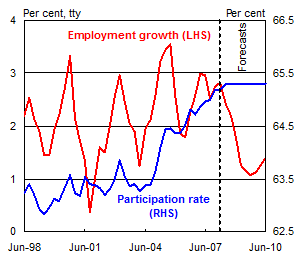
Source: ABS Cat. No. 6202.0 and Treasury.
The participation rate is expected to remain at around current record levels of 65¼ per cent over the forecast horizon despite an easing in labour demand. This is expected to be supported by the high rates of participation from skilled immigrants.
As a result of the labour force growing more strongly than employment as economic growth eases, the unemployment rate is still expected to increase to 4¾ by June 2009, rising to 5¼ per cent by June 2010.
Prices
Since Budget, escalating world oil prices have added to existing inflationary pressures. Headline inflation is now expected to be 4¼ per cent through the year to the June quarter 2008 and 3½ per cent to the June quarter 2009, before easing to 2¾ per cent through the year to the June quarter 2010. In 2007-08 and 2008-09 this is ¼ of a percentage point higher than at Budget.
Nominal unit labour costs are expected to remain solid in the near term before slowing in 2009-10, reflecting a pick up in productivity growth and stabilising wages growth.
Concomitantly, a stronger $A relative to Budget is providing slight insulation against the sharp rise in global oil prices. More broadly, however, the beneficial pass-through of the stronger currency on imported goods prices remains muted.
At a component level, dwelling rents are expected to grow strongly throughout the forecast horizon, reflecting a tight housing market and record low vacancy rates. Food prices are also expected to remain high in the near-term given strong world demand and constrained domestic supply following prolonged drought. Further forward, the expected recovery in farm production is likely to place downward pressure on domestic food prices through the course of 2008-09 and 2009-10.
Chart 11: Consumer price inflation
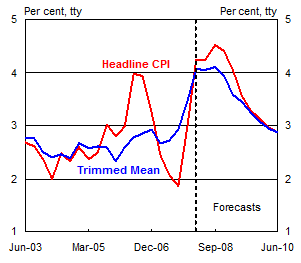
Source: ABS Cat. No. 6401.0 and Treasury.
Wages
Wage growth is expected to remain elevated in the near term as current labour market tightness and shortages of suitable labour continue to influence wage agreements. Nonetheless, wage growth is not expected to accelerate given the anticipated easing in labour market conditions. Overall wage growth has been contained in recent wage outcomes support this view, with March quarter outcomes. Further out, wage pressures are expected to ease in line with the expansion of labour supply from net overseas migration and an easing in domestic demand.
Consistent with Budget, the Wage Price Index (WPI) is forecast to grow by 4¼ per cent in 2007-08 and 2008-09, before easing to 4 per cent in 2009-10. There is, however, a risk that elevated inflation expectations feed into higher wage claims and put further upward pressure on inflation.
Reflecting the additional boost to bulk commodity prices in 2008-09, the States and Territories most directly exposed to mining activity are likely to experience the strongest wage growth over the forecast horizon.
1 This spending was included as expenditure by States and local authorities in the UEFO forecasts but has been subsequently reclassified as renovation spending by households.
